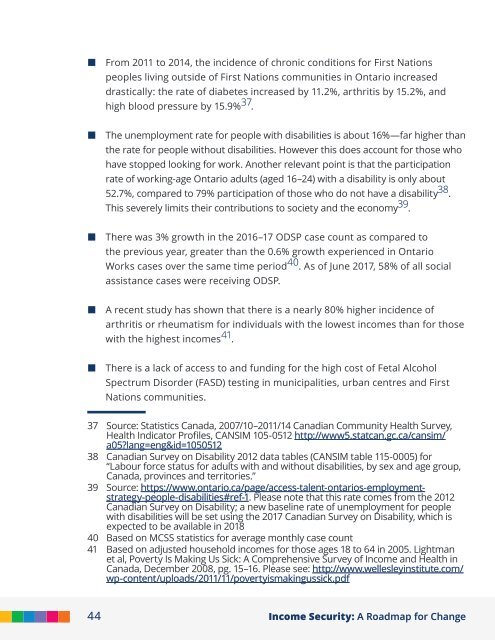Income Security: A Roadmap for Change
Create successful ePaper yourself
Turn your PDF publications into a flip-book with our unique Google optimized e-Paper software.
• From 2011 to 2014, the incidence of chronic conditions <strong>for</strong> First Nations<br />
peoples living outside of First Nations communities in Ontario increased<br />
drastically: the rate of diabetes increased by 112%, arthritis by 152%, and<br />
high blood pressure by 159% 37 <br />
• The unemployment rate <strong>for</strong> people with disabilities is about 16%—far higher than<br />
the rate <strong>for</strong> people without disabilities However this does account <strong>for</strong> those who<br />
have stopped looking <strong>for</strong> work Another relevant point is that the participation<br />
rate of working-age Ontario adults (aged 16–24) with a disability is only about<br />
527%, compared to 79% participation of those who do not have a disability 38 <br />
This severely limits their contributions to society and the economy 39 <br />
• There was 3% growth in the 2016–17 ODSP case count as compared to<br />
the previous year, greater than the 06% growth experienced in Ontario<br />
Works cases over the same time period 40 As of June 2017, 58% of all social<br />
assistance cases were receiving ODSP<br />
• A recent study has shown that there is a nearly 80% higher incidence of<br />
arthritis or rheumatism <strong>for</strong> individuals with the lowest incomes than <strong>for</strong> those<br />
with the highest incomes 41 <br />
• There is a lack of access to and funding <strong>for</strong> the high cost of Fetal Alcohol<br />
Spectrum Disorder (FASD) testing in municipalities, urban centres and First<br />
Nations communities<br />
37 Source: Statistics Canada, 2007/10–2011/14 Canadian Community Health Survey,<br />
Health Indicator Profiles, CANSIM 105-0512 http://www5statcangcca/cansim/<br />
a05?lang=eng&id=1050512<br />
38 Canadian Survey on Disability 2012 data tables (CANSIM table 115-0005) <strong>for</strong><br />
“Labour <strong>for</strong>ce status <strong>for</strong> adults with and without disabilities, by sex and age group,<br />
Canada, provinces and territories.”<br />
39 Source: https://wwwontarioca/page/access-talent-ontarios-employmentstrategy-people-disabilities#ref-1<br />
Please note that this rate comes from the 2012<br />
Canadian Survey on Disability; a new baseline rate of unemployment <strong>for</strong> people<br />
with disabilities will be set using the 2017 Canadian Survey on Disability, which is<br />
expected to be available in 2018<br />
40 Based on MCSS statistics <strong>for</strong> average monthly case count<br />
41 Based on adjusted household incomes <strong>for</strong> those ages 18 to 64 in 2005 Lightman<br />
et al, Poverty Is Making Us Sick: A Comprehensive Survey of <strong>Income</strong> and Health in<br />
Canada, December 2008, pg 15–16 Please see: http://wwwwellesleyinstitutecom/<br />
wp-content/uploads/2011/11/povertyismakingussickpdf<br />
44 <strong>Income</strong> <strong>Security</strong>: A <strong>Roadmap</strong> <strong>for</strong> <strong>Change</strong>
















